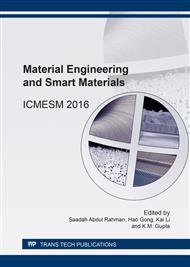p.52
p.56
p.61
p.69
p.73
p.79
p.85
p.89
p.94
Modeling of Interface Heat Flux and Thermal Field of Mold Materials during Gravity Die Casting
Abstract:
One of the key controllable and influential factors to obtain a casting simulation, representative of reality, is the choice of boundary condition. The thermal boundary condition to be specified at the metal-mold interface must account for complex heat transfer phenomena associated with solidifying casting. The present study aims at estimating the heat flux at the interface of the mold and the solidifying metal by Inverse Heat Conduction Problem (IHCP) approach. Solidification studies were conducted on casting of aluminum reinforced with boron carbide composite. Copper, cast iron and stainless steel were used as mold materials. The temperature data of the mold was recorded from the beginning to end of solidification using k-type thermocouples connected to temperature data logger. This time-temperature history was used as input to the IHCP algorithm to simulate the interface heat flux and thermal field of the mold. The results indicate that the interface heat flux is highly transient and varies with the variation in the thermo-physical properties of the mold materials. The study also demonstrates that heat conduction is one dimensional in copper mold and two dimensional in cast iron and stainless steel mold during phase change.
Info:
Periodical:
Pages:
85-88
Citation:
Online since:
March 2017
Authors:
Keywords:
Price:
Сopyright:
© 2017 Trans Tech Publications Ltd. All Rights Reserved
Share:
Citation:


